We live in a world of vast information that can be instantly acquired and shared. Our students need to be prepared for a future that will have careers and discoveries that we cannot yet imagine. They will be part of a generation that will need to make informed decisions to address issues that will affect our world.
To prepare our children, the New Hartford Central School District guarantees that all students participate in rigorous, high-quality programs that integrate the important concepts and procedures of science, technology, engineering, the arts, and math. In a supportive, professional climate grounded in collaboration and research, our teachers will deepen their knowledge and extend their understanding through professional development.
What is STEAM? | Why STEAM Education at NHCSD? | Our STEAM Community Partners | What to expect from the STEAM Initiative | What does STEAM look like at NHCSD?
What is STEAM?
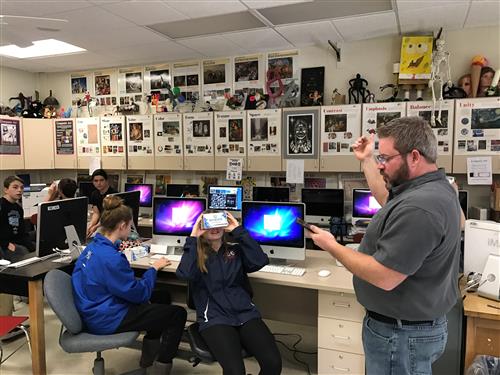
With an award-winning tradition of arts education at New Hartford Central Schools, it is only appropriate to integrate the arts into an interdisciplinary approach to instruction.
The STEAM initiative at New Hartford strives to ensure three essential educational elements:
- To promote total engagement and motivation through relevant projects and problems that provide challenges and have many solutions.
- To provide an interdisciplinary approach to curriculum and instruction that encourages creative thinking and problem-solving.
- To inspire students to embrace growth mindsets and divergent thinking opportunities.
Why STEAM Education at NHCSD?
Simply put, many education and economic experts believe that the future of employment and economic vitality as a nation resides in STEM (or as we prefer, STEAM) related careers.
Our present challenge is to discover new educational pathways to help students prepare for the future.
“For the United States to maintain its preeminent position in the world it will be essential that the Nation continues to lead in STEM, but evidence indicates that current educational pathways are not leading to a sufficiently large and well-trained STEM workforce to achieve this goal.”
Barack Obama, 44th President of the United States
For further information and research on this topic, please consider:
Our STEAM Community Partners
Education researchers Ann Myers and Jill Berkowicz (2015) suggest in their book The STEM Shift that one key to successful STEM or STEAM programs is to create partnerships throughout the community to enhance learning opportunities inside and outside of the classroom.
The district STEAM initiative has spent the last several years nurturing those relationships. Our Community Partners have already made many contributions to New Hartford Central Schools, from sponsoring and presenting at our Family Spring STEAM event, hosting site tours, and donating time and STEAM learning materials to our schools.
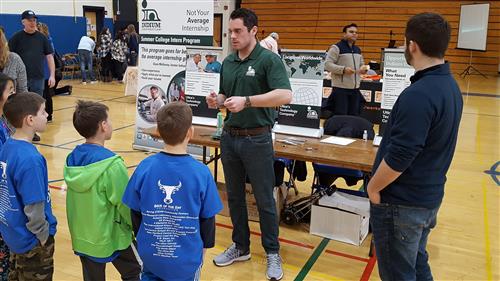
Indium Corporation–represented here by New Hartford alumni James McCoy (center) and Tom Donovan (far right)–was one of the district’s first Community Partners. Mr. McCoy helped in the planning phase of the district’s first Spring STEAM event, has been a guest presenter in class, and has hosted members of the STEAM committee for educational site tours.
Thank you to all of our Community Partners for your ongoing support!
Indium Corporation®
Utica Zoo
Utica College
Arizona State University
Air Force Research Laboratory
The Home Depot
S.R. Sloan
AX Enterprise
Comets Save the Day Foundation
The Foundation Group, Inc.
News Channel 2 WKTV Utica
Golden Artist Colors®
PTA
Cafe CaNole
Stronghold Animation
Sculpture Space
Mohawk Regional Information Center
What to expect from the STEAM Initiative
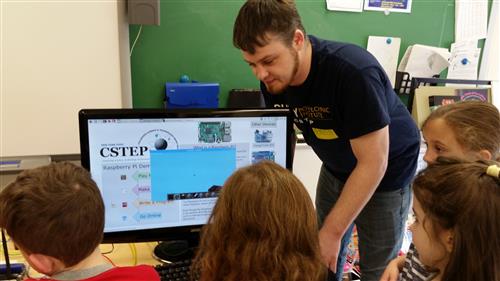
- STEAM concepts and practices in all grade levels and throughout all content areas
- Curriculum, instruction, and materials that focus on integration, establish relevance, emphasize 21st-century skills, provide challenge in a safe learning environment, and allow for a variety of outcomes
- High expectations and strong support for all students
- Appropriate opportunities for every student
- Assessment that is an integral part of the instruction which guides teachers and enhances student learning
- The use of technology to facilitate learning
- Learning opportunities that promote creative, divergent thinking and problem-solving
- Ideas are connected to other subjects and everyday life by actively building new knowledge from experience and prior knowledge
- The ability to communicate ideas, reasons, arguments, and evidence through reading, writing, and speaking
- An environment that promotes discourse and respect for diverse approaches to learning
What does STEAM look like at NHCSD?
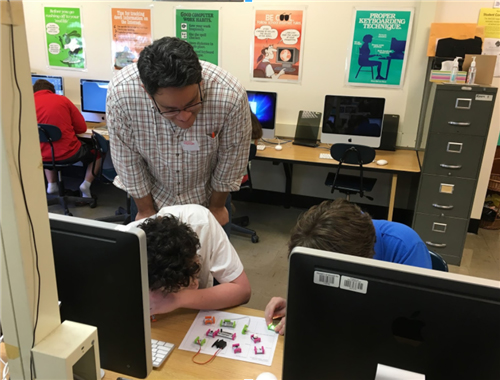
- Hour of Code
- PTA Reflections Program
- Shell Eco-marathon
- Novel Engineering
- Science Olympiad
- Family Spring STEAM Day
- Makerspaces
- Google Expeditions
- Emerging Technologies and DELTA ELA
- Computer coding infused into Elementary School Curriculum
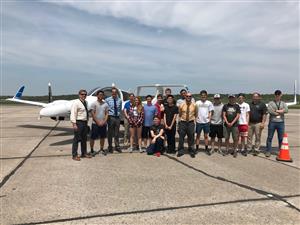
With the Mohawk Valley’s emergence as part of a major drone testing corridor, STEAM coursework such as in “Emerging Technologies” takes on greater importance and should gain interest from students interested in STEAM-related careers. The photo above captures Emerging Technologies and Project Lead the Way students visiting the drone testing site at Griffiss Airport in Rome, New York.
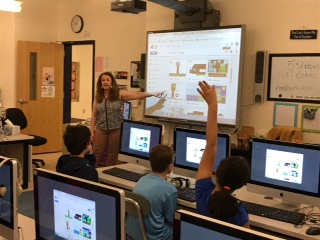
Elements of computer coding and applications have been integrated into the elementary school curriculum, as seen here during Mrs. Christine Raynard’s Computer Technology class.
Program Spotlight: Novel Engineering

Editor’s Note: Portions of the following article first appeared in the NHCSD “Tech Spotlight.” Novel Engineering is set to expand as a district-wide program, Grades K-6, for the 2017-2018 academic year.
What is great for students at New Hartford Central School is having teachers that are strong advocates for new pathways of student discovery in STEM-related fields. Significantly, teachers are urging a focus on instructional methods that strike a balance between the arts and sciences. A unique example of this effort is the “Novel Engineering” pilot underway at Bradley Elementary School.
“Novel Engineering” encourages students to interact with literature in a proactive, hands-on manner. In this approach, students read stories appropriate to their grade level, then doff their literary caps in exchange for engineering ones. With each story they read, students determine a problem that character faces. Students then use engineering skills to design and build a tool that would, hypothetically, solve a character’s problem, thus bringing the story to an alternative resolution.
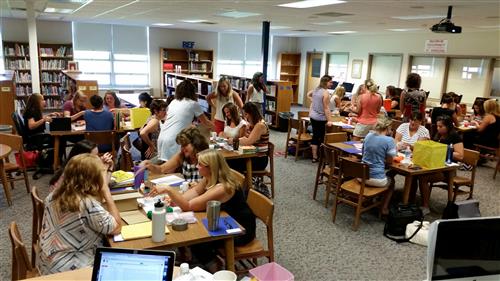
“Novel Engineering” is one facet of a comprehensive pre-engineering institute: the Center of Engineering Education and Outreach at Tufts University. The New Hartford Central School STEAM committee adopted “Novel Engineering” as a pilot program for the 2016-2017 school year. It has been one of the several strategies used to explore STEM-related coursework at the elementary school level. As the Board of Education discovered at its regular meeting of November 15 [2016], the results of the pilot are promising. At the meeting, students from Mrs. Lisa Meyers’s Grade 4 class presented one of their latest “prototypes.” Board of Education members learned that the prototype was designed to help “Stormie,” an over-sized protagonist of the short story Stormalong, build more appropriate-sized living quarters. As Mrs. Meyers notes, “My students are focusing on what the National Education Association calls ‘The Four Cs.’ These are critical thinking, collaboration, communication and creativity/innovation.” Meyers adds, “What is so inspiring is the familiarity our students are gaining with the engineering design process, and how to think like engineers!”
That process is similar to the one that Meyers’s colleague Mrs. Kathy Donovan, the district’s STEM enrichment teacher, utilizes in her classes every day. Just as the Grade 4 students shared with the Board of Education, these steps include: create, plan, imagine, ask, and improve. Mrs. Donovan explains that teachers do not have to look too far to find good sources of problem-solving inspiration. “Our pilot is using readings from Journeys, a literacy program adopted district-wide, for our elementary schools to use regularly throughout the year.”
While New Hartford elementary students will no doubt engage in literacy/STEM challenges equal to that of “Stormie” in the days to come, several of their teachers will face some classroom problem-solving challenges of their own. Three New Hartford faculty, including Mrs. Meyers, Mrs. Donovan, and Myles Elementary Special Education teacher Mrs. Melissa Gehringer are finishing their first semester in the Teacher Engineering Education Program offered (mostly online) at Tufts University. Evidently, they are already transforming their studies into classroom instruction, through the “Novel Engineering” pilot as well as the district’s continued commitment to enrichment opportunities through DELTA STEM.
Read the article “Engineering a Better Classroom Experience” at TuftsNOW.
Program Spotlight: Family Spring STEAM
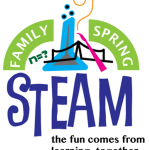
Since 2016, hundreds of New Hartford Central School elementary students and their parents have participated in the now annual Family Spring STEAM event. Spring STEAM family members eager for hands-on learning about science, technology, engineering, the arts, and math find numerous and exciting experiences throughout the event.
Program Spotlight: Project Lead the Way
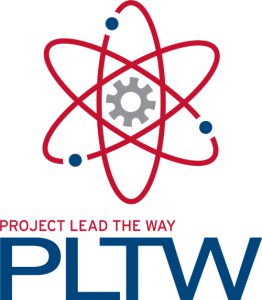
Project Lead The Way (PLTW) is the leading provider of rigorous and innovative Science, Technology, Engineering, and Mathematics (STEM) education curricular programs used in middle and high schools across the U.S.
STEM education is at the heart of today’s high-tech, high-skill global economy. For America to remain economically competitive, our next generation of leaders — the students of today — must develop the critical-reasoning and problem-solving skills that will help make them the most productive in the world. STEM education programs like the one offered by PLTW engage students in activities-, projects-, and problem-based (APPB) learning, which provides hands-on classroom experiences. Students create, design, build, discover, collaborate and solve problems while applying what they learn in math and science. They’re also exposed to STEM fields through professionals from local industries who supplement the real-world aspect of the curriculum through mentorships and workplace experiences.
PLTW’s comprehensive curriculum for engineering and biomedical sciences has been collaboratively designed by PLTW teachers, university educators, engineering and biomedical professionals and school administrators to promote critical thinking, creativity, innovation and real-world problem solving skills in students.
We are a PLTW certified school. The certification means that students will be eligible for college credit through Rochester Institute of Technology (RIT), if they qualify, in the areas of Design and Drawing for Production, Digital Electronics and Computer Integrated Manufacturing. All students with a math/science concentration are encouraged to take these courses.
The six goals for the PLTW program are to:
- Increase the number of young people who pursue engineering technology programs requiring 2 and 4 year college degrees.
- Provide clear standards and expectations for students success in the program.
- Provide leadership and support that will produce continuous improvement and innovation in the program
- Provide equitable and inclusive opportunities for all academically qualified students.
- Reduce the future college attrition rate within 2-4 year engineering programs.
- Contribute to continuing America’s national prosperity.
For more information on the program visit the PLTW Website.